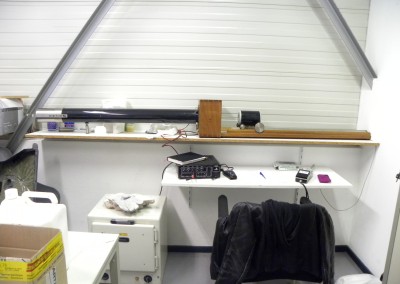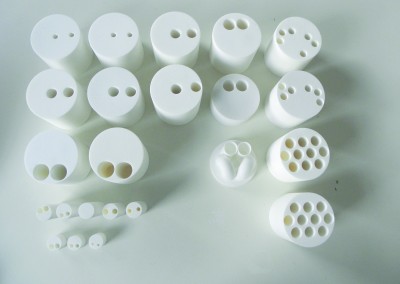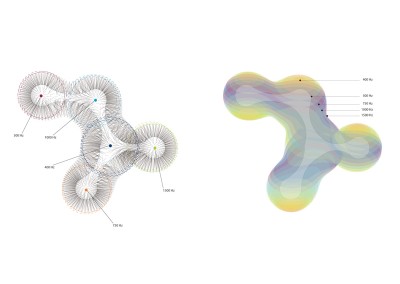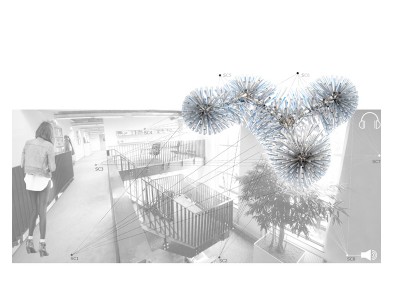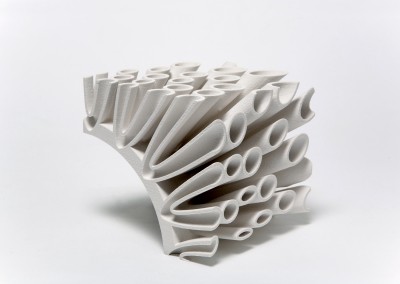BEYOND | call for projects
ENTRY #29 | acoustics by additive manufacturing
Project Brief
This project explores the potentials of optimising (room) acoustics when employing additive manufacturing and parametric design. More specifically, it focuses on sound absorbing structures that regulate performance by geometrical characteristics, using the principle of passive destructive interference. The aim is to establish a new method where geometry, production technique and acoustic performance are interrelated and fully integrated in the design process. By taking advantage of the emerging digital technologies, the proposed acoustic treatment is highly customizable and is shaped by the soundscape of its context.
It is well known that acoustics constitute important performance criteria for the built environment and that sound absorption, is the main technique for tailoring sound in room acoustics. Offices, auditoriums, houses, (enclosed) public space; all kind of spatial settings offer and require their own set of acoustical parameters. Consequently, it becomes essential to acoustically treat space with unique and customised solutions. However, current sound absorbers have limited possibilities in customisation; mostly due to design and fabrication limitations.
In order to investigate solutions for highly customized sound absorbers, this research focuses on absorbers based on the principle of passive destructive interference (PDI). This principle can be described as follows:
through an air-path with a certain length, sound waves from a common source are entering from both sides. At a given point, the sound waves meet with a 180° phase difference and therefore cancel each other by destructive interference. This method uses the sound itself to drastically reduce noise and does not require a secondary sound source like a speaker; hence it can overcome many problems of active noise control methods like energy use of equipment, etc.
The exploitation of the geometry-related capabilities of PDI absorbers, points towards new acoustic structures with improved performance and increased freedom in design and material choice. In order to achieve acoustic-driven design, it becomes crucial to formulate rules that are based on identified relations between geometry and performance. For the definition of this relationship, the research starts with a series of physical tests in the impedance tube. This contributes in measuring and understanding the acoustic consequences of different geometrical parameters of the examined air-path system.
In the impedance tube (see also photo 1 _ impedance tube.jpg), the normal sound absorption coefficient of cylindrical samples is measured at mid-low and/ or mid-high frequencies. In total, more than 30 prototypes are designed, produced and measured for this project (see also photo 2_ prototypes_ measured samples.jpg). The cylindrical samples are fabricated with Polyamide [PA12] by Selective Laser Sintering. SLS is chosen, among other AM techniques, because of its powder-based nature and its economical and fast features in production. The self-supporting capabilities of the technique allow the fabrication of highly complex internal air paths.
The physical tests are organised in 3 iterative loops and examine various geometrical parameters of the air-paths. The conclusions derived from the analysis of the results are further transformed into a set of design rules, which include the definition of a set of boundary values for the main geometrical characteristics of the air-paths, such as their length and diameter (see also photo 3_design 1.jpg). Having identified these design rules, the attributes of the meaningful geometric properties can be parameterized in order to support the design of the final products, by using parametric modelling. The final design of the PDI-absorber consists of the air-paths that employ U-shaped units which are oriented towards sound(see also photo 3_design 2.jpg). The corresponding prototype (see also 5_prototype_ design) constitutes a segment of a bigger design proposal and therefore it is semi-functional. The design process of the absorber is elaborated in a parametric definition, which is set-up in Rhino 4 (McNeel & Associates) and Grasshopper (Plug-in for Rhino).

